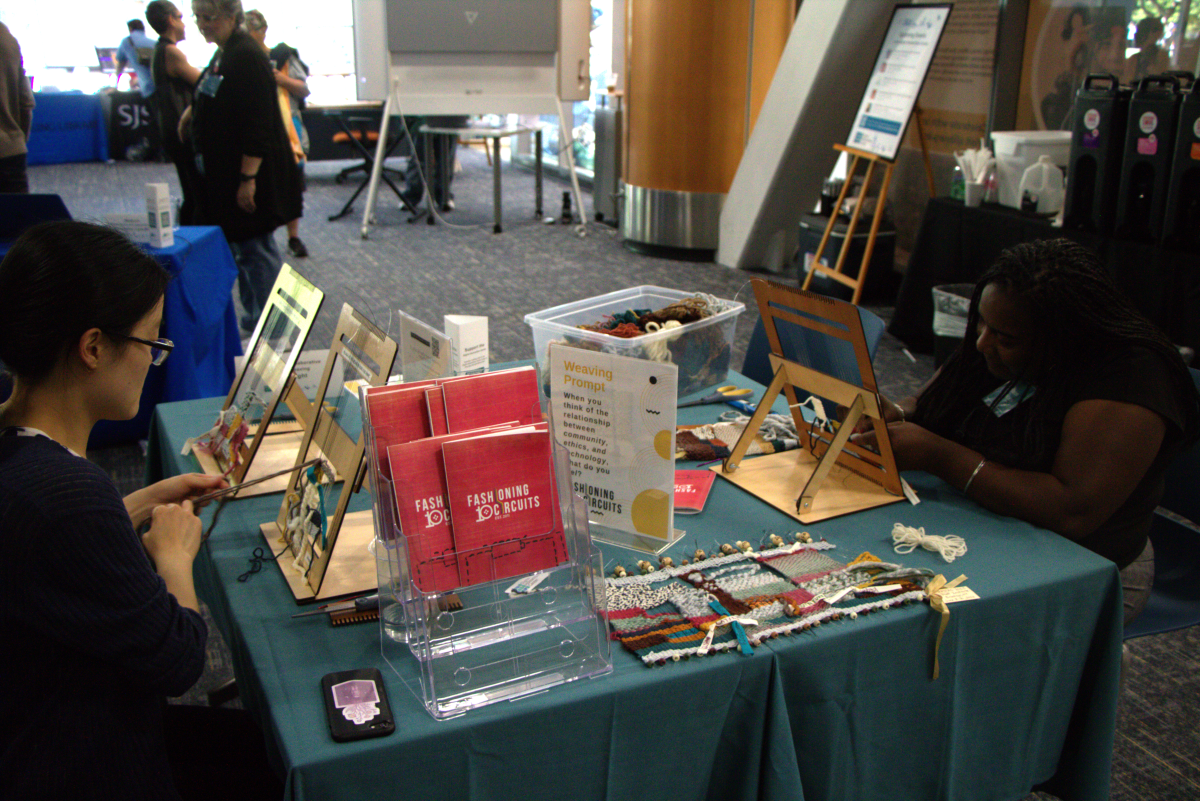
The Digital Humanities Center’s open house on the San José State campus flaunted the prowess of art and technology of students, artists, and researchers on Tuesday at the Dr. Martin Luther King Jr. Library.
Christina Mune, associate dean of innovation and resource management at the MLK library, has been coordinating library affairs for five years.
“The idea of the Digital Humanities Center is it connects people with tools or approaches to taking their scholarship, or their research or teaching style and infusing it with a technology that expands its reach or impact,” Mune said.
The open house showcased the work of students, professors, and other faculty members.
Nick Szydlowski, a scholarly communications and digital scholarship librarian at the MLK library, was one of the participants showing off their academic work.
Szydlowski’s exhibit showed off his color organ, a keyboard that controls colors and shapes, made using JavaScript programming.
JavaScript is a coding language that is primarily used to create complex features for web pages, according to javascript.info.
“This is an idea that’s been around a long time,” Szydlowski said. “(For) hundreds of years, people have imagined what (you could) do, would it be fun to just play a keyboard and instead of hearing it, you see it?”
The program corresponded specific keys to shapes and colors, and made those corresponding colors and shapes bounce to the top of the screen when pressed.
Aditi Rajesh Shah, a research assistant at the SJSU Research Foundation, helped Szydlowski create improvements for the project in JavaScript.
“There are people who often visit us, (and) they ask us … ‘What is the Digital Humanities Center doing?’ ” Shah said. “So we explain (it to) them and what this project does.”
Christopher Luna-Mega, SJSU assistant professor of music theory, technology and composition, was another artist at the exhibit who showed off a program that created music in real time.
Luna-Mega’s exhibition involved an algorithmic program.
While operating this program, one could use a small soundboard to adjust melodic patterns, such as pitch or reverb, of a constant sound being played into a pair of headphones.
“It allows the user to change specific parameters … It allows for the user to be shifting these parameters as the software is doing its thing,” Luna-Mega said. “It also allows the user to get a real time notation of whatever the user is (doing).”
The program initiates the sounds to be played instantaneously and transcribed into musical notation, according to Luna-Mega.
Luna-Mega explained this can be a faster alternative to composing music through improvisation.
“The process from (improvising) to writing it down (is) a huge turnoff a lot of the time,” Luna-Mega said. “So I can generate sound for ten minutes, and maybe I can even come up with a piece that’s just on one go.”
Luna-Mega said the software’s developers also allowed for other uses from people who are not musicians or composers,
“(For) a lot of students who don’t have a music theory background or an instrumental music performance background, (the program) already allows them to (make) music,” Luna-Mega said. “Of course, it needs a little tweaking, it’s not (just going) from A to B and you’re done (and) you have your score ready to give to the performer, but at least you can sit down and make music with an ensemble as we’re doing it.”
Another exhibit at the open house was a showcase for Adobe Firefly, which is a software application by Adobe that creates generative artificial intelligence images.
One student typed in “depressed John Wick eating ice cream,” which Firefly shortly created an image in a matter of seconds.
Raymond Lam, Adobe trainer and instructional designer at the MLK library spoke about the tools SJSU students have access to as a way to create art.
“I know a lot of people have heard about image model generators, but they might not have had an opportunity to try it out,” Lam said. “Here at the Digital Humanity Center, my table here is to help people see it for the first time and experience it.”
Lam said that some students are unaware that SJSU provides all its students with the full Adobe Suite, from Photoshop to Premiere Pro.
The Digital Humanities Center is one of many places where community members and students can find art.
Mune said that the first floor of the MLK library is the space for digital exhibits, but the library also contains other art exhibits on the second and fifth floor.
“Right now we’re just starting (and) we have our rolling screens,” Mune said. “In the future, we’ll have screens all over the walls, (a) big video wall with sound, so we can do more.”
Mune said because San José has a rich cultural history, these art exhibits bring opportunities for community members to show their art and increase research impact.
“We hope that within the next year, (we can) really open it up for people to propose different exhibits and to bring people in from all over the community,” Mune said.